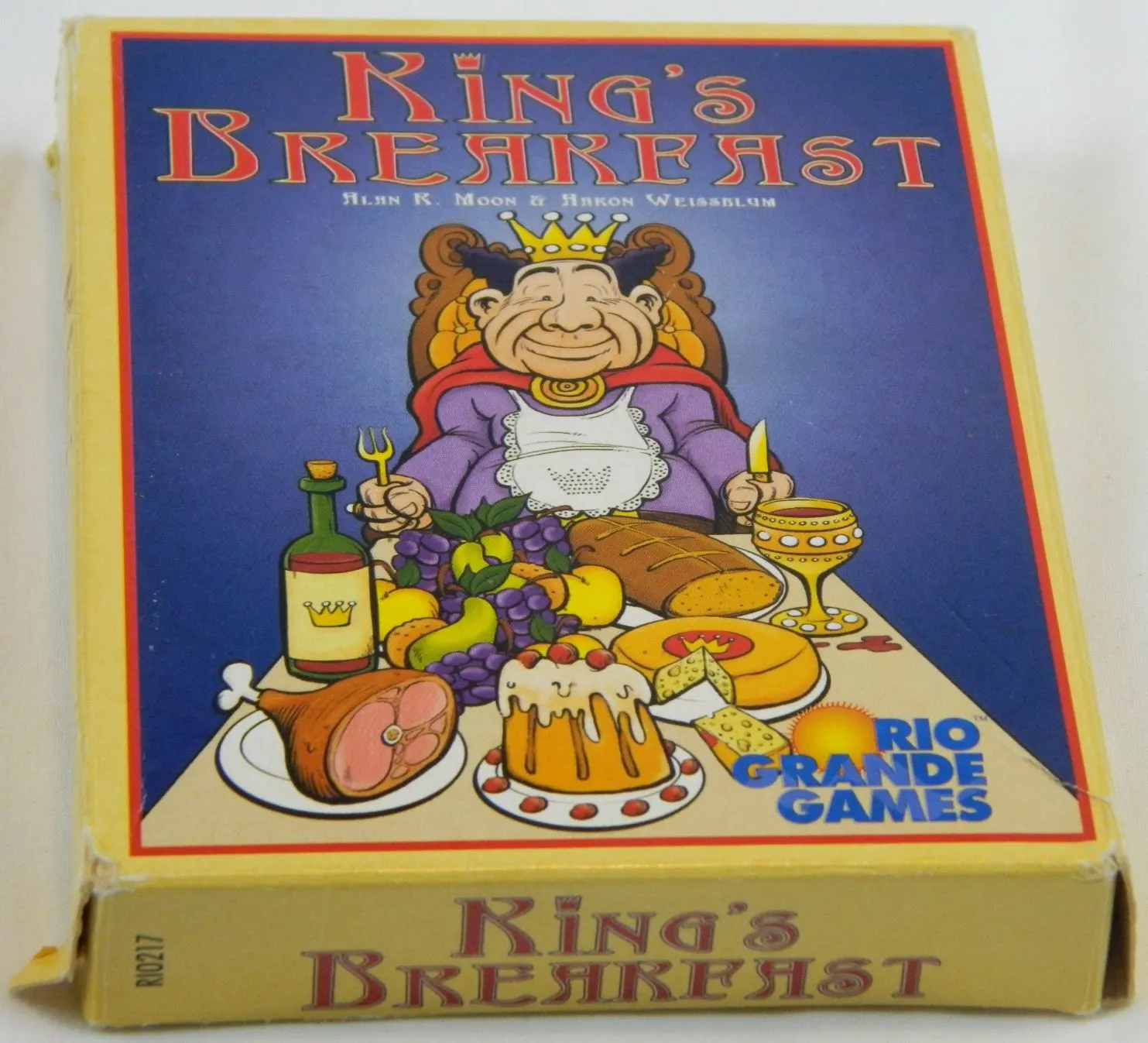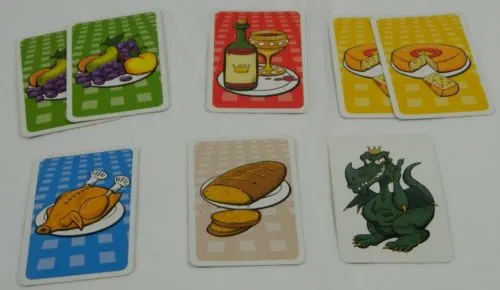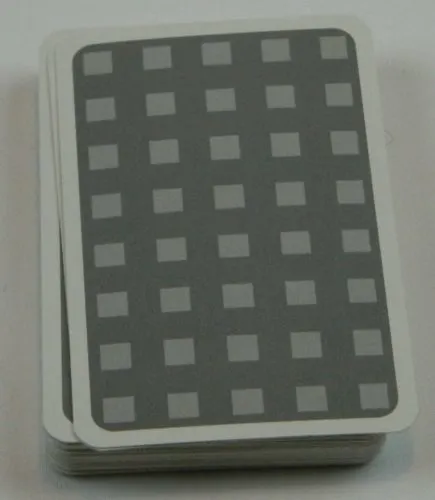Any regular readers of Geeky Hobbies will know that I am a big fan of Alan Moon. He created arguably my favorite board game of all time Ticket to Ride, along with quite a few other beloved games. Just to illustrate how much I like Alan Moon’s games so far we have taken a look at 10 Days in Africa, 10 Days in the USA, Airlines Europe, Elfenland, Incan Gold, Skyline 3000, Ticket to Ride Europe, Ticket to Ride First Journey, Ticket to Ride Marklin, and Walk the Dogs. I think the thing that I appreciate most about Alan Moon’s games is that he does a great job finding the right balance between simplicity and strategy. Today I am looking at a card game that he designed with Aaron Weisblum called King’s Breakfast (also known as King Lui). With how much I generally enjoy his games, I had pretty high expectations for King’s Breakfast. King’s Breakfast might not quite live up to some of Alan Moon’s other games, but it is a fun little card game that the whole family can enjoy.
How to Play King’s Breakfast
Setup
- Place the box on one side of the table. This is the area where the king will place the portions he acquires throughout the game.
- Choose the first chef by whichever method you prefer. This player will be the chef for the first course. The role will rotate each round.
- The chef shuffles the cards and places them face down on the table.
Playing the Game
The game is played over a number of courses. Each course consists of three steps:
- Preparing the Table
- Taking Portions
- Serving the King
After these three steps are completed the game will move onto the next course. The role of chef will pass to the next player to the left.
Preparing the Table
The chef will take a number of cards from the top of the deck equal to the number of players times two. These cards will be placed face up on the table. The cards will be sorted by their colors/pictures. Each type of card will be placed into its own pile where all of the players can see how many cards are in the group.
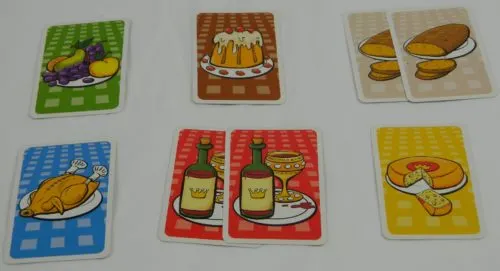
These are the available cards for the current round. Players will have the opportunity to take one of these groups of cards for their turn.
If any Emerald/dragon cards are revealed, each card is placed into its own group.
Taking Portions
Starting with the chef and moving clockwise, each player will get to take one action for their turn. For their turn players can choose one of the following actions:
Taking a dish from the table
If a player wants one of the types of food that are face up on the table, they will take all of the cards of that type. Players are not allowed to only take some of the cards. The cards that are taken are added to the player’s hand.
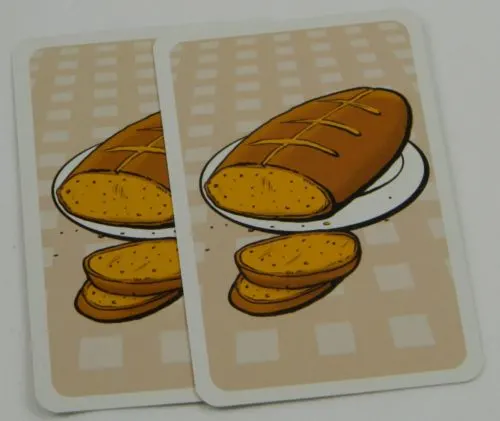
This player decided to take the bread cards that were on the table. They will have to take both of the bread cards.
Taking a portion from the supply
A player can choose to take the top portion card from the draw pile and add it to their hand. If a player chooses this action, they do not need to show the card to the other players.
If a player takes an Emerald/dragon card with this action, the card must be placed face up on the table. The player will not get to draw another card to replace the Emerald card they drew.
Using Emerald
If an Emerald card is face up on the table and the king has at least two cards, a player can choose this action. When a player chooses to use an Emerald card they will choose two cards controlled by the king and discard them along with the Emerald card. The two cards taken from the king could be the same type of card, or they could be two different types of food.
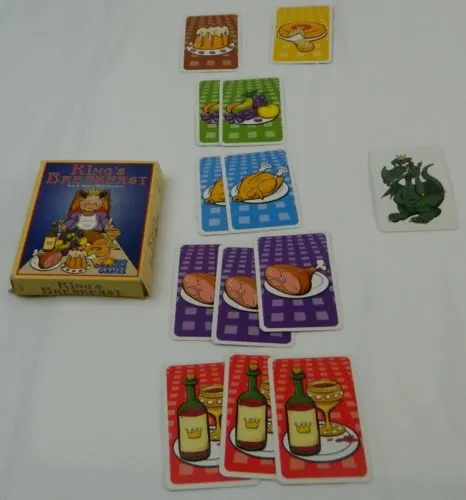
The current player chose to take the Emerald card. They will choose two of the king’s cards to discard.
Serving the King
After each player has taken an action, the king will be given all of the food cards still on the table. The Emerald cards will remain in the center of the table. If there are no food cards face up on the table, the king won’t get any cards this course.
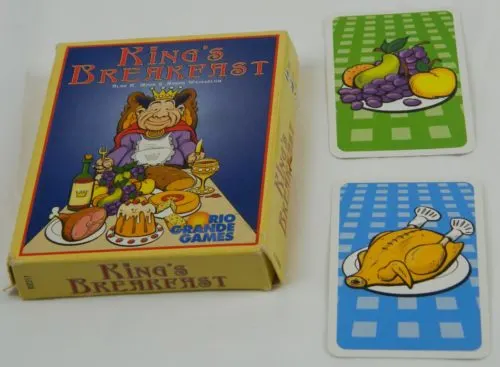
Two cards were left on the table after all of the players took their turns. The two remaining cards are given to the king.
All cards given to the king should be sorted by their types so players can easy see how many cards of each type that the king currently has.
End of Game
The game ends when there are not enough cards to place two cards for each player face up on the table at the beginning of a course.
Players will compare the number of cards that they have of each type of food to the cards held by the king. If a player has more of a type of food than the king, they will discard all of the cards of that type from their hand.
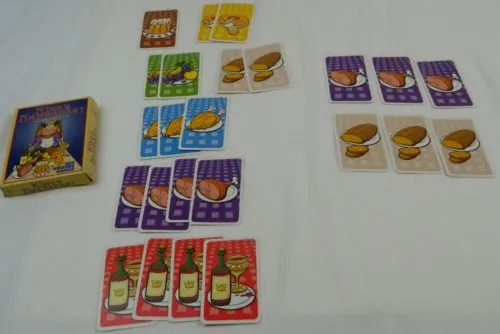
On the right there are two sets of cards that one player collected during the game. They collected three hams during the game. As the king has four hams, the player will get to keep their ham cards. The player also collected three bread cards. The king only collected two bread cards so the player will have to discard their bread cards.
Players will then score points for all of the cards remaining in their hand. Each card left in a player’s hand is worth points equal to the number of that type of food that the king has.
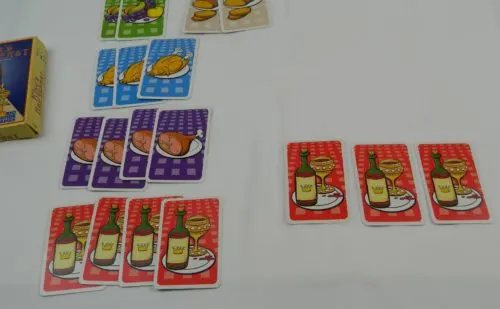
The three wine cards on the right were collected by one of the players during the game. As the king acquired four wine cards during the game, the player will score twelve points (4 x 3) from their wine cards.
The player that scores the most points wins the game. If two or more players are tied for the most points, the tied player who had to discard fewer cards will win.
My Thoughts on King’s Breakfast
At its core King’s Breakfast shares a lot in common with your typical set collecting game. Cards are put out on the table and players take turns choosing one type of card to add to their hand. Like all set collecting games, players are trying to acquire as many cards as possible while trying to focus on a couple types. Players will score points for the number of cards that they collect of each type. This is not all that different from your typical set collecting game.
Where King’s Breakfast differentiates itself is that it utilizes one little twist on the formula. While players are busy collecting cards, the king will take any cards that the other players don’t want. As he is the king he obviously needs the most food of each type. Therefore you need to be observant of what cards you take as you never want to get more of a type of food than the king. Ultimately you are trying to acquire up to the number of cards of each type that the king owns. The more cards of each type you acquire, the more points that you will score. If you get greedy and have more of a type of card than the king though, you lose all of the potential points from that type of card.
This might not seem like much of a twist at first, but it drives most of the gameplay in King’s Breakfast. Ultimately the goal of the game is to be greedy but never too greedy. For example you can choose one card of a type or two to four cards of another type. Getting multiple cards on your turn is quite tempting as it could score you considerably more points. You need to be careful though as you never want to get too much of any type of card or all of those cards will become worthless. This is a real balancing act that you have to deal with throughout the entire game. If you are too passive you will leave points on the table making it hard to win. If you are too aggressive though, you will get stuck with a lot of cards that you will eventually have to discard.
What makes this decision even more interesting is that any cards not taken by one of the players will go to the king. Taking a bunch of cards of the same type can be tempting, but you need to be willing to let these cards get to the king. This is for two reasons. First you need to allow the king to get more of a type of card than you possess. If not it doesn’t matter how many cards you collected since they will all be worthless. The other reason is every card of a type that you allow to get to the king increases the value of each of those type of cards in the game. There is a real tradeoff between keeping a card and letting it go to the king. Unless you are the last player in a turn you don’t know what cards will ultimately make their way to the King. This makes the last player of each round quite valuable as they ultimately get to choose which dishes go to the king. If you are not the last player though, you need to just hope that the cards that you want make it to the king.
The one mechanic that I haven’t talked about yet are the Emerald/dragon cards. These cards are pretty limited as they only make up five of the 110 cards in the game. For the most part the Emerald cards are used to mess with the other players. Whenever a player takes one of these cards they are able to discard two of the cards acquired by the king. This doesn’t really directly help the player that uses the card as it is more about reducing the other players’ scores. Basically if you can remember what cards the other players have in their hands, you can use an Emerald card to reduce the king’s share below the number of cards held by the other players.
I honestly had some mixed feelings about the Emerald cards. For the most part they are used to add a little take that to the game. By forfeiting one or more cards for yourself, you can really mess with another player’s strategy. At least early in the game, there isn’t much use for the dragon cards. This is mostly because in the early game you don’t know how things are going to turn out. You could guess right and hurt the intended player, or you could end up wasting your turn or even hurting yourself later in the game. I personally would wait to use these cards as they become more valuable later in the game. I normally don’t like take that mechanics, but I actually don’t mind them in this game. You can’t spend too many turns hurting other players as you will just hurt your own scoring potential even more. A good use of one of these cards could make the difference between winning or losing, but you need to spend most of your time on your own cards.
At first glance King’s Breakfast might seem to be like every other set collecting game, and in some ways it is. I am a big fan of this genre so this wouldn’t be that big of a problem. The set collecting genre is not the most original though, as most games from it are pretty similar. If it was just your typical set collecting game, King’s Breakfast would still be an enjoyable game. The king mechanic is what really makes the game though. Managing how many cards you have of each type versus what the king has is the key to doing well in the game. You generally want to stay below what the king currently has, but you sometimes have to take a chance and take more cards in order to potentially score more points later in the game. This mechanic is really satisfying as it includes a decent amount of strategy.
Along with the satisfying gameplay is the fact that King’s Breakfast is quite easy to play. This is a trademark of most games made by Alan Moon, so I wasn’t surprised by how easy the game is to play. If you have ever played a set collecting game before, the only mechanic that you really need to learn is the king mechanic. There is nothing particularly difficult about the game where you could probably teach it to most players within a couple minutes. The game has a recommended age of 7+ which seems about right. The simplicity of the game means that it can also be played pretty quickly. I would guess that most games could be played within 15-20 minutes. This makes King’s Breakfast a great filler game, or a game that you could play a couple times in a row.
There is a lot that I liked about King’s Breakfast. There are a couple issues as well though.
Probably the biggest issue with the game is that you don’t always have a huge impact on your own fate. With King’s Breakfast being a simpler game that plays quickly, this isn’t a huge problem. There will still be times in the game though where you wish you had more control. This comes from a couple factors. First the game relies on a decent amount of luck. Most of the cards will eventually make their way into the game. When they come out though can play a pretty big role in the game though. Depending on your strategy, you could have the cards you need come out at the right or wrong times. This could play a pretty big role in how many points you ultimately score.
In addition to luck, the other players can mess with your plans quite a bit. The obvious way to mess with other players is to use the Emerald cards to hurt the food items that other players are collecting. You could be scoring a lot of points from one type of card, and then another player could use an Emerald card to make you score no points from that type of card. Remembering what cards the other players take can be key when choosing how to use dragon cards. In addition to messing with the king, other players could just take cards that you want or prevent them from making their way to the king. In a way you need to just hope that the other players aren’t trying to mess with your strategy.
I don’t know if this is necessarily a bad thing, but King’s Breakfast does start out a little slow. To begin the game you are mostly just guessing when choosing which cards to take. It is too early in the game to know what will happen and in what combinations cards will come out in later in the game. There really is no reason to put too much thought into what you do for your first couple of turns as there is no way to predict how your actions will impact the rest of the game. Towards the midpoint the game really picks up though. Each decision becomes quite important as you start to see how the cards of each type get divided up. Thus there is quite a bit to analyze in deciding what cards to take and which to try to get to the king.
Finally I wouldn’t consider King’s Breakfast to be the deepest game. The game has a decent amount of strategy, but it is not the type of game that you should spend too much time analyzing. Your best option on most turns is usually pretty obvious. When it isn’t though, you shouldn’t spend too much time figuring out what you want to do. King’s Breakfast is not meant to be taken that serious. It works best as a family game or one where you don’t have to put too much thought into any given move. I like the game’s simplicity, but it likely will turn off some players. If you want a highly strategic game, you will be disappointed by King’s Breakfast.
As for the game’s components I thought they were pretty good. The game only comes with cards, but I liked them. The artwork is kind of kiddy, but I think it works well with the game’s more family friendly atmosphere. The cardstock is also pretty thick where they should last. I think the best thing about the cards is that the game comes with quite a few of them. There are 110 cards in the game. This allows more players to play the game as well as allowing more rounds to be played.
Should You Buy King’s Breakfast?
Heading into King’s Breakfast I had pretty high hopes as I am a big fan of Alan Moon’s games. I would say that King’s Breakfast is probably worse than most of his games that I have played, but it is still a good game. It is not the deepest game, but I think it works well as a family or filler game. On the surface it feels very similar to your typical set collecting game. What differentiates the game though is the fact that you can’t acquire more cards of each type than the king. This creates an interesting balancing act as you try to acquire as many cards as possible without acquiring too many thus destroying the value of those cards. The game does a really good job finding the right balance between being easy to play and yet having enough strategy to keep players interested. At times it does feel like you don’t have as much impact on your fate as you would like though.
My recommendation for King’s Breakfast comes down to your feelings about more family friendly set collecting games and the game’s premise. If you generally like more strategic games or don’t think the premise sounds all that interesting, King’s Breakfast probably won’t be for you. If you like Alan Moon’s other games though and think the premise sounds at least somewhat interesting, I think you will enjoy King’s Breakfast and should consider picking it up.
Buy King’s Breakfast online: eBay. Any purchases made through these links (including other products) help keep Geeky Hobbies running. Thank you for your support.

